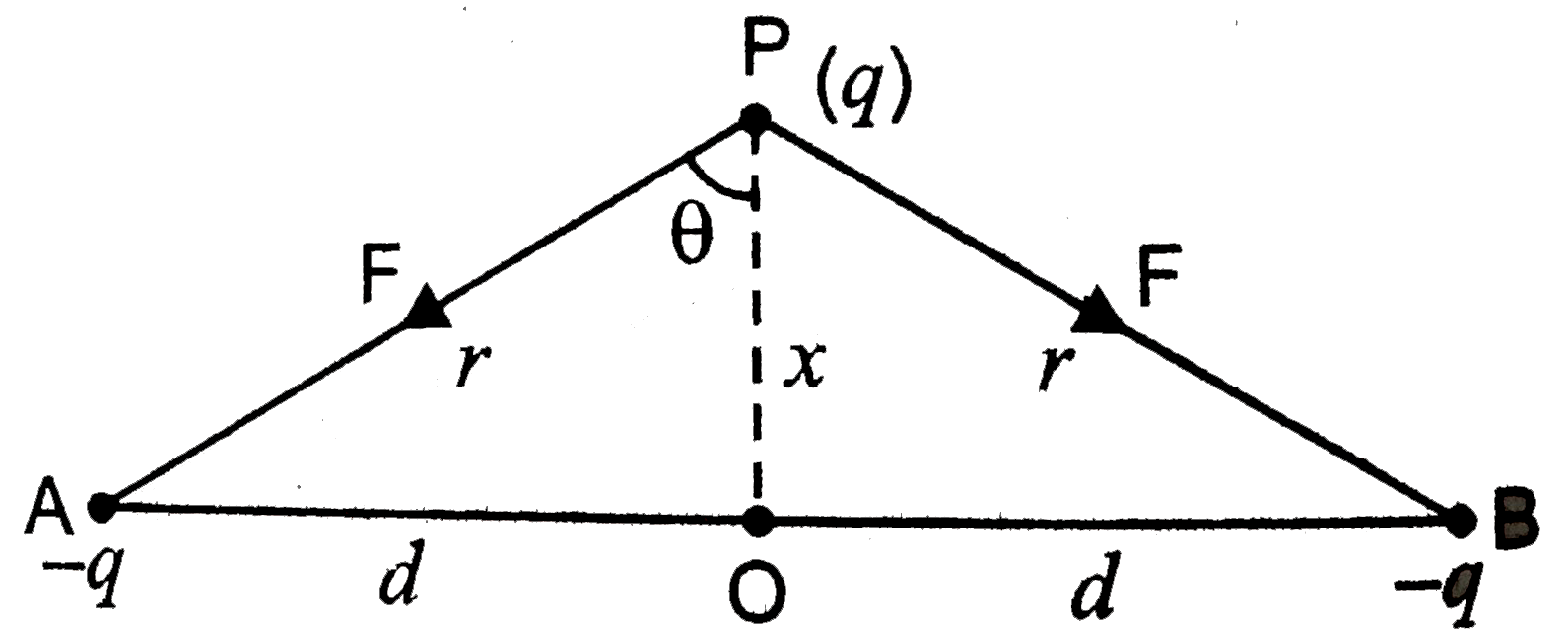Two charges −q each are fixed separated by distance 2d. A third charge q of mass m placed at the mid-point is displaced at the mid-point is placed slightly by x(x<<d) perpendicular to the line joining the two fixed charges as shown in Fig. Show that q will perform simple harmonic oscillarion of time period.
T=[8π3∈0md3q2]1/2
![Two charges -q each are fixed separated by distance 2d. A third charge q of mass m placed at the mid-point is displaced at the mid-point is placed slightly by x (xltltd) perpendicular to the line joining the two fixed charges as shown in Fig. Show that q will perform simple harmonic oscillarion of time period. T = [(8pi^(3) in(0) md^(3))/(q^(2))]^(1//2)](https://d10lpgp6xz60nq.cloudfront.net/physics_images/PR_XII_V01_C01_S01_623_Q01.png)
In fig, two charges −q each are held at A and B whereAB=2d. A third charge +q of mass m is placed at 0, middle point of AB. Let it be displaced perpendicular to AB, through a small distance OP=x, force of attraction at p towards A and B are each
F=q(q)4π∈0r2, where AP=BP=r
Horizontal components of those forces cancel out. Vertical components along PO add. If ∠APO=θ, the net force on q along PO is F'=2Fcosθ
F=q(q)4π∈0r2(xr)=2q2x4π∈0(d2+x2)3/2
When x<<d,F'=2q2x4π∈0d=Kx,whereK=2q24π∈0d3
i.e., force on charge q is proportional to its displacement from the center 0 and is directed towards 0, Hence, motion of charge q would be simple harmonic, where
ω=√KmandT=2πω=2π√mK=2π=√m.4π∈0d32d2=[8π3∈0md3q2]1/2

Similar Questions
Two charges, each of −q, are fixed and separated by a distance 2d. A third charge q of mass m is placed at the mid-point of the two fixed charges. q is displaced slightly by x(x⟨), perpendicular to the line joining the two fixed charged as shown in the figure. q will perform simple harmonic oscillation if the time period of (SHM) is T=απ3ɛ0md3q2][12). Find α
'(##CEN_KSR_PHY_JEE_C18_E01_013_Q04##)'View SolutionTwo electrons are fixed at a seperation of 2d from each other.A proton is placed at the mid point and displaced slightly in a direction perpendicular to line joining the two electrons. Find frequency of oscillation of proton
View Solution
Knowledge Check
- Question 1 - Select One
Two electrons each are fixed at a distance '2d'. A third charge proton placed at the midpoint is displaced slightly by a distance x(x<<d) perpendicular to the line joining the two fixed charges. Proton will execute simple harmonic motion having angular frequency : (m = mass of charged particle)
A(2q2πε0md3)12B(πε0md32q2)12C(q22πε0md3)12D(2πε0md3q2)12 - Question 2 - Select One or More
Two point charges q each are fixed at (a,0) and (-a,0). A third charge Q is placed at origin. Electrons potential energy of the system will
Aincrease if Q is slightly displaced along x-axisBdecrease if Q is slightly displaced along x-axisCincrease if Q is slightly displaced along y-axisDdecrease if Q is slightly displaced along y-axis - Question 3 - Select One
Two points charges +4q and +q are separated by distance r, where should a third point charge Q be placed that the whole system remains in equilibrium
A2r3 from qBr3 from qCr2 from qDr3 from 4q
Two positive point charges , each Q , are fixed at separation d. A third charge q is placed in the middle. Describe the equilibrium of the third charge.
View SolutionTwo charge q and –3q are placed fixed on x–axis separated by distance d. Where should a third charge2q be placed such that it will not experience any force ?
 View Solution
View SolutionTwo charges q and 3q are placed fixed on x-axis separated by distance 'd'. Where should a third charge 2q be placed such that it will not experience any force ?
View SolutionTwo charge q and –3q are placed fixed on x–axis separated by distance d. Where should a third charge2q be placed such that it will not experience any force ?
 View Solution
View SolutionTwo charges Q and -3Q are placed fixed on x-axis separated by a distance 'd' Where should a third charge 2Q be placed such that it will not experience any force?
View Solution

